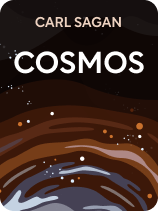

This article is an excerpt from the Shortform book guide to "Cosmos" by Carl Sagan. Shortform has the world's best summaries and analyses of books you should be reading.
Like this article? Sign up for a free trial here .
What is Carl Sagan’s book Cosmos about? What’s out there in the vast reaches of space? Are we alone in the universe?
Renowned astronomer Carl Sagan offers some insight into these questions and many more in his widely acclaimed book, Cosmos. In this book, he provides a comprehensive description of the science, philosophy, and history of astronomical discovery, from ancient Ionia to the time of the book’s publication in 1980.
Here’s a brief overview of Cosmos.
Cosmos Book Overview
The book Cosmos by Carl Sagan is an exploration of the universe. In this book, Sagan gives a comprehensive description of the science, philosophy, and history of astronomical discovery, from ancient Ionia to the time of the book’s publication in 1980. He discusses some of the obstacles posed by religious belief and institutions to scientific inquiry throughout history, and he celebrates the victories of the scientific endeavor. Although much research has been done in astronomy since the publication of Cosmos, the book remains timeless in the sense of wonder and awe it evokes. Sagan provides us with food for thought on some of the biggest questions pondered by humanity—questions about our place and significance in the vast universe.
Sagan was an American astronomer who spent most of his prolific career in Cornell University’s Laboratory for Planetary Studies. His 1977 book The Dragons of Eden, about the evolution of human intelligence, won a Pulitzer Prize. In the 1980s Sagan became a popular science writer and public figure, due largely to the success of Cosmos and the accompanying television show of the same name. His popularity continued following the publication of his 1985 science fiction novel Contact, which was made into a movie. Sagan died in 1996, leaving a vast body of intellectual and literary work as his legacy.
This guide will summarize the key ideas in Cosmos in three parts:
- In Part 1, we’ll summarize Sagan’s description of the evolution of life on Earth, and his thoughts about the possibility that a similar evolution could occur elsewhere, based on what we know about the universe.
- In Part 2, we’ll look at the history of humanity’s inquiry into the cosmos, outlining the astronomical discoveries made by important scientific figures.
- In Part 3, we’ll delve into Sagan’s theories about the possibility for interstellar travel, and the search for extraterrestrial life.
As this book was published in 1980, we’ll update the information with the scientific discoveries made since that time, as well as provide perspectives from other experts in related fields.
Part 1: The Vastness of Space and Time
In this section, we’ll discuss Sagan’s description of the vastness of the cosmos (or universe), and our place in it. We’ll begin by examining how life evolved on Earth to find our place within that timeline. After situating ourselves, we’ll zoom out to look at Sagan’s bigger picture of where Earth fits into the timeline and space of the universe. Ultimately, when we look at what’s known about the cosmos, we’ll discover that in the grand scheme of things, we’re pretty insignificant.
Humanity’s Place on Earth
Sagan begins the story of humanity’s history by teaching us that all life is made of carbon-based organic molecules, but there was once a time on Earth without life. How was it possible for life to come from non-life? Let’s look at a timeline of how that process occurred and discuss Sagan’s thoughts on whether the same thing could occur on other planets.
About 4.6 billion years ago, the Earth formed out of condensed gas and dust. The fossil record tells us life arose about 4 billion years ago, meaning that for 600 million years there was no life on Earth. According to Sagan, hydrogen-based molecules that are found throughout space were gradually broken down by the sun’s energy, and they formed into other more complex molecules—from one-celled plants to multicellular organisms. Sagan says that scientists have been able to replicate this on a much smaller scale in the laboratory. Scientists can create organic molecules that may have the potential to evolve into more complex life forms by exposing common inorganic gas molecules to an energy source, such as ultraviolet light. So, Sagan says, we know it’s possible to create living molecules from simple non-living gasses.
About 1 billion years ago, simple plants had evolved. Sagan tells us that for about 3 of the 4 billion years of life on Earth, the dominant life form was blue-green algae that covered the oceans. Those plants gradually changed the atmosphere by generating oxygen, allowing for many types of organisms to arise and others to die off. The process of evolution by natural selection gradually shaped these simple organisms into all of the life forms we know today.
About 10 million years ago, early hominids appeared, according to Sagan, with modern humans emerging only about 300,000 years ago. This means humans have existed for approximately .007% of the Earth’s history.
Evolution on Other Planets
Could life have evolved similarly on other planets? Sagan says it’s certainly possible. The gasses from which the first living molecules formed exist everywhere in the universe. However, for 3 billion years, life on Earth never evolved past blue-green algae, so Sagan points out that evolving large complex life forms is much harder than the origin of life itself. Therefore, he says that if there is life on other planets, it’s more likely to be simple organisms, because the time required to evolve complex intelligent life means that, statistically, the majority of life in the universe would be in some stage of evolution preceding the complex life form stage.
However, it’s certainly possible that there are some planets on which life has been evolving as long as it has been on Earth, or even much longer. Sagan speculates that life forms that have evolved much longer than humans may become extinct (for various reasons including self-destruction, which he argues is happening with humans), leaving only a relatively small time window, on the cosmic scale of time, for multiple forms of complex, intelligent life to exist simultaneously.
Sagan also points out that life elsewhere in the cosmos is probably nothing like we imagine, because our imaginations are limited by what we know. Given the many possibilities in the way molecules can combine, along with the vast possibilities for how characteristics could evolve, Sagan says that any life that has evolved elsewhere would most likely be out of our realm of imagination.
Earth’s Place in the Universe
While Earth seems special and central to our perspective, from the cosmic perspective it’s a minuscule piece of rock floating in a vast universe. To begin to understand just how vast the universe is, Sagan explains that distances between the celestial objects are so huge that we measure them in speed of light units. Light travels 6 trillion miles (10 trillion km) in one year, and a little over 11 million miles (18 million km) in one minute. Earth is 8 light-minutes away from the sun.
So, to understand our place in the universe as Sagan describes it, we’ll begin with Earth and zoom out. The Earth and our eight planet neighbors all orbit the sun, due to its gravitational pull. This is called our solar system.
Zooming out further from our own solar system, Sagan tells us that the sun is a relatively ordinary star that resides toward the outer reaches of the Milky Way galaxy. A galaxy is an enormous cluster of stars, all linked together by gravity. A typical galaxy has an average of about 100 billion stars, Sagan says, and the cosmos includes about 100 billion galaxies.
Our own galaxy, the Milky Way, is relatively large, containing about 400 billion stars. Sagan says that the majority of those stars could potentially have satellites (planets) revolving around them, as does our sun. He says that evidence would suggest that most probably do, which suggests hundreds of billions of potential planets in just our galaxy alone, not to mention the other 100 billion known galaxies.
If these numbers convey how vast the matter of the universe is, Sagan goes on to point out that despite the staggering number of stars and other orbiting objects in the universe, it actually consists of far more empty space than matter.
All of this considered, Sagan argues that we must conclude that we’re not that significant in the grand scheme of things. Not only is Earth’s place in the universe insignificant, but we humans are only one of innumerable possible forms of life, and even among the diverse life forms on Earth, we’re descended from blue-green algae, just like everything else. Sagan says that there’s no scientific justification for claiming that our place or position in the world is unique or special relative to anything else.
Despite this, he points out that many scientists have been persecuted and ostracized for making such claims. Next we’ll discuss some examples of those who have challenged the perspective of Earth-centered and human-centered privilege.
Part 2: History of Astronomical Thought
Humans in all places and times have been fascinated by the skies. We’ve used the stars to guide us, to mark the passage of seasons, and make sense of our place in the world for as long as we’ve existed. But our understanding of the nature and order of the universe, and our place in it, has evolved substantially over time. Sagan gives a historical picture of how humanity developed its beliefs “from chaos to cosmos.”
In this section, we’ll briefly outline the Western history of astronomical discovery, as presented by Sagan, from Thales of Miletus in ancient Ionia, to Isaac Newton in 17th-century England.
The Ionian Awakening
Sagan’s history begins between 600 and 400 BC, when a revolution of scientific thought occurred in Ionia, a Greek settlement on the Aegean coast in what is now Turkey. Ionia is often considered the birthplace of science, in the Western tradition. This revolution was sparked by a scientist named Thales of Miletus, who Sagan says was the first known scientist bold enough to attempt to explain the world without appealing to the supernatural. He explains that this had far-reaching consequences, as it prompted a shift from a world made by gods to a world made by natural processes.
Sagan details the revolutionary discoveries made during this time, including the idea that the sun was the center of the universe (heliocentric), rather than the Earth (geocentric). Copernicus is often given credit for the heliocentric model of the universe. However, Sagan says that Aristarchus is the first person known to have proposed that the Earth revolves around the sun, in Ionia, in 280 BC, 1800 years before Copernicus. Therefore, he points out that Galileo described Copernicus as “restorer and confirmer” of this worldview, not the originator of it.
Scientists in this period also proposed that the orbits of the planets were elliptical rather than circular, and that gravitational forces were at work in their orbiting of the sun.
According to Sagan, Aristarchus’ “great legacy” is the argument that we’re not special. He argued that humans are not the center of the universe, nor is our planet. This idea can be extended to many aspects of life—Aristarchus challenged the prevailing anthropocentric (“human-centered”) worldview. Sagan explains that this was a bold challenge to the social order, as it conflicted with a religious worldview that asserted that humans are uniquely created by the Gods, as well as with the idea of natural social hierarchies.

———End of Preview———
Like what you just read? Read the rest of the world's best book summary and analysis of Carl Sagan's "Cosmos" at Shortform .
Here's what you'll find in our full Cosmos summary :
- Carl Sagan's insights into some of the universe's biggest questions
- The history of astronomical discovery, from ancient Ionia to 1980
- Why humans will need “multigenerational” spacecrafts to explore space






